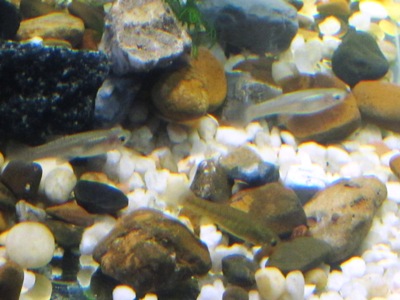 Maintaining a simple aquarium stocked with native species of fish and other aquatic life can be a rewarding experience.
Maintaining a simple aquarium stocked with native species of fish and other aquatic life can be a rewarding experience.
Choosing an aquarium is an important part of the process. A basic system typically includes a small to mid sized aquarium, filter, light, and basic tools. Some smaller models can reside on a desk or shelf while larger tanks require special stands to support their weight.
Filtration systems vary from simple bubbler-type units to powerful pump-filter units. Choosing a filter can be critical as its performance can have considerable impacts on plant and animal life. A good unit should be reliable, quiet, and correctly matched to the aquarium size.
It is important to inspect and clean the pump and filter periodically. This should be done every 1-2 weeks initially, after which a routine can be chosen, based on how quickly the filters become restricted. When the filter is cleaned, the pickup tube and pump impeller should also be flushed in order to maintain peak efficiency.
Activated charcoal should also be replaced periodically. Depending on the type of filter, charcoal may be separate from the filter element or be an integral part of the filter module.
Lighting is important for several reasons. If aquatic plants will be included in the aquarium, proper lighting is necessary. Most aquarists choose a cover with built in lighting. Alternatively, an aquarium can be placed near a window
Gravel, rocks, and other objects are also important additions to a freshwater aquarium. Gravel should be course enough to allow some water to flow through the bottom. A few larger stones can be useful for anchoring plants as well as providing shelter for fish or other aquatic life.
Some enthusiasts prefer a background, while others choose to keep the aquarium visible from all sides. Specialty suppliers offer a wide range of backgrounds or one can be fabricated. Backgrounds need to be made from a waterproof material as they are exposed to frequent splashes of water.
Although aquatic plants require special care, they can be a big asset to a freshwater aquarium. In most areas, a wide range of native plants can be collected from local ponds, creeks or streams.
Choosing native fish and other aquatic life varies based on locality and other factors. In most locations a variety of local species are available, such as mosquitofish, killifish, suckers, minnows, and other small fish species.
Most native fish species will adapt quickly to a diet of tropical fish food. Some hobbyists choose to supplement dried foods with tiny morsels of meat or plankton. An incredible range of plankton and small invertebrates can be harvested in many local bodies of water. These include isopods, insect larvae, copepods, grass shrimp, crayfish and other aquatic life.
Maintenance of native freshwater aquariums depends on the size of the tank, filtration system, number and type of inhabitants, and other factors. Small tanks with few fish or other aquatic life are by far the easiest to maintain.
A wide range of chemicals are available for aquarists. In some applications, chemicals may be required to maintain pH or other levels.
Aquarium books have a wealth of information related to the pastime. Other important resources include native freshwater fish field guides, books on aquatic plants and animals, and other nature-themed resources.
Photographing aquarium species is an art in itself. Although aquarium photography can be enjoyable, it can require considerable skill and equipment.
A basic understanding of fish and wildlife regulations is important before stocking a native species aquarium. Most states or provinces offer handbooks, websites, or hotlines to help hobbyists learn about which species can be legally collected. Of particular concern are endangered species, which may be protected from collection.
Another important issues concerns the release of native and non-native aquatic species back into the environment. Some species can be invasive in certain environments and their release into the wild may be prohibited. All of these issues require proper identification of aquatic species.